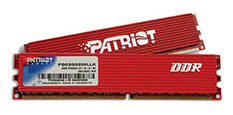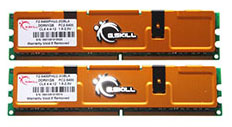Pre-AM2 Mid-Range Buyers' Guide, May 2006
by Jarred Walton on May 9, 2006 6:30 AM EST- Posted in
- Guides
Memory Recommendations
While we wait for AMD socket AM2 to launch, we still need to have separate memory recommendations for AMD and Intel systems. Just as I'm done recommending single core processors for midrange computers, I'm upgrading both systems to 2GB of RAM. If you're running a dual core processor and doing a lot of multitasking, the extra memory will definitely come in handy. Prices have also dropped to the point where even good quality 2GB kits don't cost that much. It was about 18 months ago that we stopped recommending 512MB configurations for midrange computers, which means it's about the right time to bump up to the next level of memory. Hopefully, in another 18 months we will be able to recommend 4GB of RAM for less than $200. |
| Click to enlarge |
DDR Memory: Patriot PC-3200 2x1024MB EPLL (2-3-2-5-1T)
Price: $190 shipped (Retail) - $55 Mail-In Rebate until 5/15/2006
Choosing a 2GB kit of DDR memory was actually relatively easy. There are kits out there that will overclock higher (without using lower memory ratios), but the majority of them cost quite a bit more. There are also a lot of mail-in rebates currently available for DDR memory, most likely due to the pending launch of AM2. This Patriot memory comes with the lowest timings you can find on any DDR 1GB DIMM, and it also happens to be one of the cheapest 1GB DIMMs available. My experience is that you can push the memory up to around DDR-450 with relaxed timings, so combined with the memory ratios on AMD motherboards you can still achieve good overclocks. If you're willing to spend a bit more money, Corsair, OCZ, G.Skill, Kingston, and Crucial are all reasonable alternatives - and potentially cheaper, depending on whether or not you take advantage of the mail-in rebate.
 |
| Click to enlarge |
DDR2 Memory: G.Skill PC-5300 2x1024MB Extreme LA (4-4-4-12)
Price: $148 shipped (Retail)
Moving to the DDR2 recommendation, there are thankfully no mail-in rebates to worry about. Balancing maximum bandwidth against latency and price, DDR2-667 looks to be the sweet spot. The G.Skill memory offers reasonable timings of 4-4-4 at that setting, and the price is only about $15 more than DDR2-533. A quick glance at the DDR price shows that without mail-in rebates, DDR2 definitely has the advantage, and a higher potential bandwidth doesn't hurt either. If you're thinking about DDR2 memory for the new socket AM2 platform, you might want to upgrade to DDR2-800 memory. That will bump the price up to $220 or more, but for Intel platforms we don't feel it's truly necessary (except for the extreme performance people that are buying $1000 P4XE processors). Should you spend the extra money right now to upgrade to DDR2-800, so that you can take it over to your AM2 platform in the future? Personally, I would say no - you can just sell off your current system and buy new memory if you upgrade motherboards and processors in the future. Six months from now, there will almost certainly be better DDR2 memory available anyway.










56 Comments
View All Comments
Spacecomber - Tuesday, May 9, 2006 - link
Thanks for putting up an update to your buyer's guides. I always read these with interest to get other people's insights into what they think are the most useful criteria for selecting the best components to get the job done at a good price.For me, trying to sort through whose LCD monitors really offer the most in a given price range, such as the $290 to $300 range, continues to be one of the most frustrating areas of selecting components. The fact that manufacturers of LCDs seem to have no compunction about making up whatever technical specifications they think will best help them sell their products is maddening. Perhaps someone will eventually nail them with a class-action lawsuit similar to the one that got everyone to specify the difference between CRT tube sizes and viewable sizes.
Anyway, with regard to your recommendations, I'm skeptical that any of these LCDs, except the 24 inch Acer, are actually true 16.7 million color LCDs. As you said, it's easy to get to hung up on one specification, but all these LCDs, with the exception of the Acer AL2416W, appear to be using TN based panels. This means that in addition to them most likely really only being 6-bit + 2-bit with dithering panels, they suffer from the narrowed viewing angles that is the TN panel's other main weakness. Fortunately, while most manufacturers seem to have little problem with declaring all their LCDs to be 16.7 million color monitors, many continue to still be a little more honest about the viewing angles (though even these are often fudged, as well). The viewing angles on the monitors you listed are what seem to give away the true nature of these displays. They are relatively narrow, and they show smaller angles for the vertical compared to their horizontal angles, which as far as I know is very charecteristic of TN panels.
Anyway, my only point is that the more information you can dig up and provide us about what's what with LCD panels the better. This continues to be one area of computer hardware where facts and reviews are skant and hard to find.
Thanks
Space
KorruptioN - Tuesday, May 9, 2006 - link
That BenQ FP202W 20" really is a TN panel. Some say it is a full 8-bit panel (16.7M) instead of a 6-bit panel (16.2M). I don't really know for sure. If it is indeed 8-bits, then I don't think I would hesitate to recommend it (for that price with rebate), even with the slightly restrictive viewing angles.That said, I would recommend people spend a little bit more and get the Viewsonic VX2025WM. It is a full 8-bit P-MVA panel from AU Optronics and offers the best of both worlds (response time, viewing angles, and colour depth). It can be had for just under $350. It has the height adjustment too.
kmmatney - Tuesday, May 9, 2006 - link
The BenQ web site always lists the correct number of colors a monitor supports. In this case the web site lists 16.7 million colors, so its an 8-bit display. Its also a TN panel, so viewing angle will not be as good as an MVA panel.Here's a review, though:
http://gear.ign.com/articles/699/699896p1.html">http://gear.ign.com/articles/699/699896p1.html
My experience with BenQ's is that it takes some fiddling to get the colors right, but they are very nice after that. They are not so good out-of-the-box.
Spacecomber - Wednesday, May 10, 2006 - link
Well, you might be right, but I remain skeptical about the BenQ FP202W being a 16.7 million color monitor. It seems like it would be big news if someone was successfully manufacturing TN panels with that many true colors.www.flatpanels.dk seems to think that this monitor is using a Chungwa panel (CPT CLAA201WA01) and that this panel is also found in the Acer AL2017. Acer lists their panel as supporting 16.2 million colors, typical for how 6-bit plus dithering panels are described.
Again, this just seems to emphasize how hard it is to get factual information that you can rely on when it comes to LCD monitors.
JarredWalton - Wednesday, May 10, 2006 - link
I've got the 19" 2ms and the 20" 8ms both setup right now, and I couldn't tell you (with my eyes) whether they're 6-bit or 8-bit. I need better eyes, I guess (which is actually true). I've edited the display text slightly if you want to check it out.JarredWalton - Wednesday, May 10, 2006 - link
Full reviews (with empirical data, rather than just using my eyeballs) will be coming soon.Spacecomber - Wednesday, May 10, 2006 - link
I look forward to those. With so much of the cost of a system potentially going into these monitors, not to mention their expected useful lifespan, more LCD monitor reviews will definitely be welcome.The trick will be how to go about getting those facts and then figuring out what they really mean. I know that ranslating numbers into users' experiences is easier said than done.
I'm sure that one of the reasons that there aren't very many in depth reviews of LCDs available is because this is such a difficult piece of hardware to get a good, analytic handle on.
Space
kmmatney - Tuesday, May 9, 2006 - link
I meant to put in a few more reviews:http://www.trustedreviews.com/article.aspx?page=45...">http://www.trustedreviews.com/article.aspx?page=45...
http://reviews-zdnet.com.com/BenQ_FP202W/4505-3174...
http://www.gamerz-edge.com/hardware/reviews/fp202w...">http://www.gamerz-edge.com/hardware/reviews/fp202w...
There is a review out there that compared the BenQ against a few other LCDs inlcuding the ViewSonic 20" widescreen, and the ViewSonic was deemed the better LCD.
punko - Tuesday, May 9, 2006 - link
Thanks for the Guide, Jarred.I guess sometimes its worth whining!
Punko
Yawgm0th - Tuesday, May 9, 2006 - link
I can't quite understand the recommendation of a 400W Eneremax power supply. There are more powerful modular power supplies in the same price range, with some being cheaper, even the ones from reputable brand names. There are even better PSUs in the same price range without modular cabling. A modular PSU is hardly a necessity for a mid-range computer, but a good power supply is. Enermax makes some great PSUs, but I wouldn't want to try using a 400W in a system like this, especially when there are good 500W power supplies in the same price range.